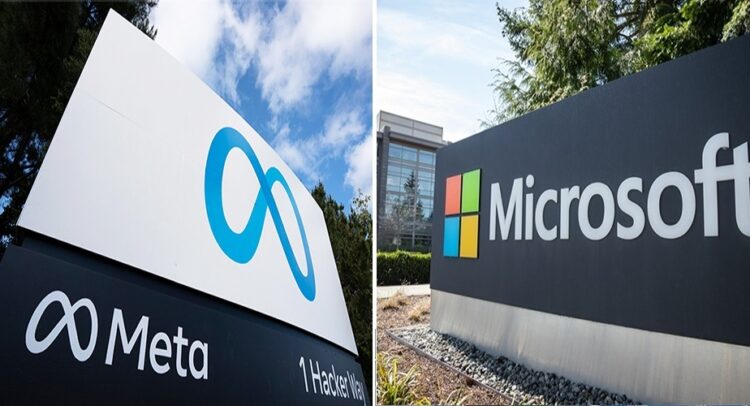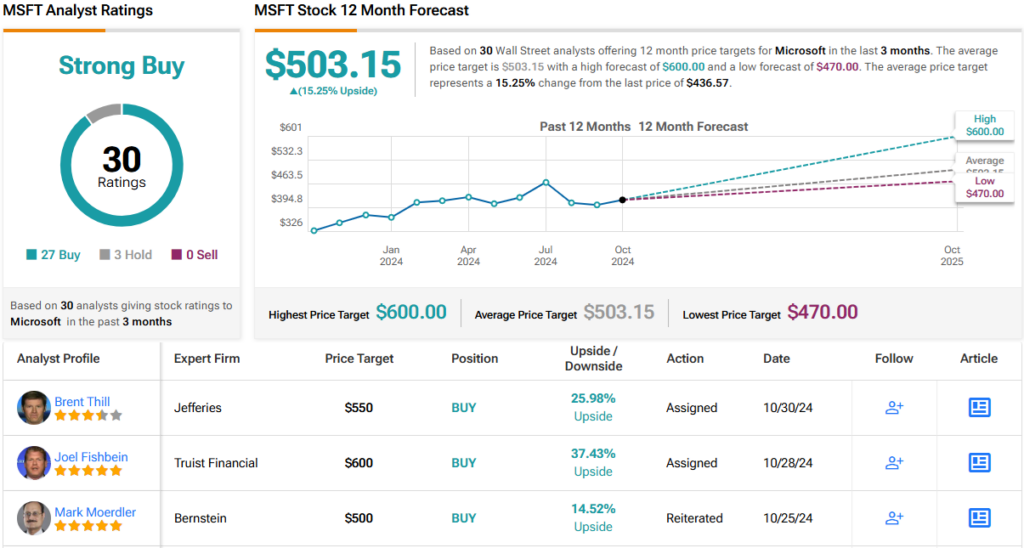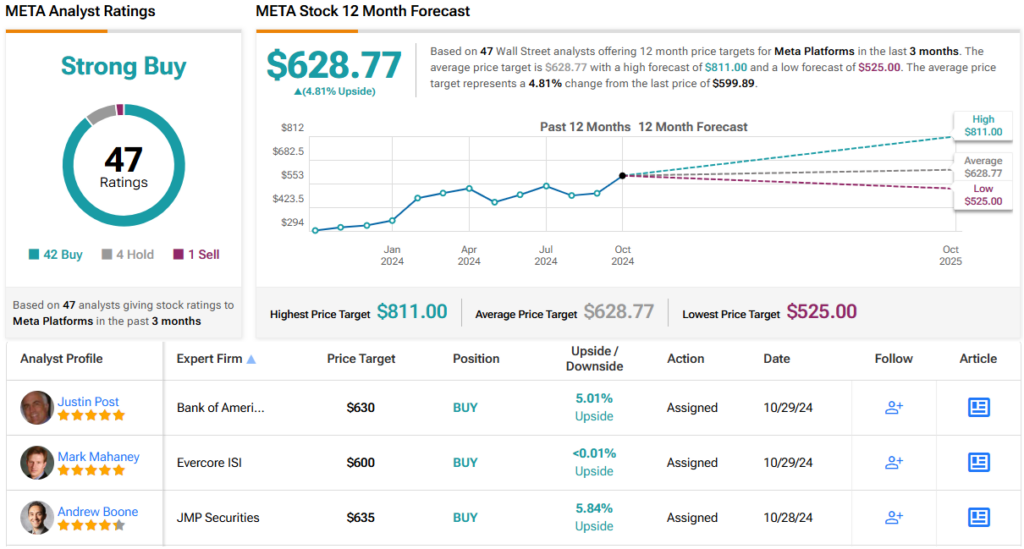Markets have continued their bullish trend, sustaining momentum over much of the past two years. Year-to-date, the S&P 500 has climbed nearly 23%, while the tech-heavy NASDAQ has surged by ~26%.
Don't Miss our Black Friday Offers:
- Unlock your investing potential with TipRanks Premium - Now At 40% OFF!
- Make smarter investments with weekly expert stock picks from the Smart Investor Newsletter
Much of this growth has been fueled by the so-called ‘Magnificent 7’ stocks – a group of mega-cap tech giants that are not only reshaping industries but also creating substantial market opportunities through their impressive growth and profitability.
Today, we await earnings reports from two of these titans, Microsoft (NASDAQ:MSFT) and Meta Platforms (NASDAQ:META). As leaders in transformative fields like generative AI and cloud computing, these companies’ results, whether positive or negative, will likely send ripples through the stock markets.
Two top-rated analysts from investment firm Bernstein are on this case, analyzing both Microsoft and Meta to see where they stand – and tagging them as the best ‘Magnificent 7’ stocks to buy ahead of today’s earnings results. Let’s take a closer look.
Microsoft
Let’s begin with Microsoft, the 800-pound gorilla of the software world. As Wall Street’s third-largest publicly traded company, Microsoft ranks just behind its peers, Apple and Nvidia, in market cap.
While OS and business software have remained the staple of the company’s business, in recent years Microsoft’s Azure cloud computing platform and its AI products have taken an increasingly important role. Azure is one of the company’s fastest-growing revenue generators – its contribution to the company’s top line in the last reported quarter, fiscal 4Q24 — was up 29% year-over-year — although we should note that it was slightly below the 30% to 31% growth that had been forecast.
Azure’s growth is supported both by the increasing popularity of subscription-based cloud computing platforms, and by Microsoft’s increasing integration of AI tech into the platform. Azure already boasts over 200 cloud-based tools available to users, and the AI integration is making them smarter, and more adaptable to user needs.
Microsoft is no stranger to AI technology. The firm was an early backer of OpenAI, the company whose ChatGPT platform launched the current growing wave of generative AI offerings, and its financial support of OpenAI now totals some $13 billion. While a valuable asset for OpenAI, it was no gift – Microsoft has a claim on 75% of the AI company’s profits, until the initial investment is recouped, and will retain a 49% royalty thereafter.
In addition to backing early developers of AI, and building AI tools into its Azure package, Microsoft is also building its own AI tools into its legacy software products. Its Copilot, an AI-powered online assistant, is already available as part of the latest updates in Windows and Office.
In the fiscal Q4 results, Microsoft reported $64.7 billion in revenue, a total that was up 15% y/y and beat expectations by $260 million. EPS, at $2.95, was up 10% from the prior year and was 2 cents per share better than the forecast.
Looking ahead to today’s fiscal 1Q25 report, the company is expected to show revenues of $64.6 billion, with earnings of $3.10 per share. These figures would represent year-over-year growth of 14% and 3.6%, respectively.
For Bernstein analyst Mark Moerdler, who is rated by TipRanks among the top 3% of Wall Street’s experts, Microsoft’s moves on cloud computing and AI are the key points here.
“Microsoft made the big bet on Cloud and succeeded beyond most people’s expectations. Now they are betting on AI and for most the jury is still out. This quarter the focus could be more on understanding the numbers than the numbers themselves. Management has re-segmented the business moving products and services around which is going to make it more difficult for investors to easily understand the results. Fundamentally nothing has changed other than the reporting — Cloud and especially Azure is a big driver of growth and if Gen AI is successful anywhere Microsoft is the most likely candidate,” Moerdler opined.
Moerdler goes on to rate MSFT shares as an Outperform (i.e. Buy), with a $500 price target that points toward a share-price gain of ~15% heading into next year. (To watch Moerdler’s track record, click here)
Overall, the software giant has picked up 30 recent Wall Street reviews, with a 27 to 3 breakdown favoring the Buys over Holds for a Strong Buy consensus rating. Shares in MSFT are priced at $436.67 and the $503.15 average target price is in-line with Bernstein’s take. (See MSFT stock forecast)
Meta Platforms
Next, we have Meta Platforms, a tech powerhouse in social media, much like Microsoft is in software. Mark Zuckerberg’s vision, launched as Facebook in 2004, has evolved into a $1.5 trillion leader. Rebranded in 2021 as Meta Platforms, the company now serves as the parent to Facebook, Instagram, Messenger, and WhatsApp – a suite of apps that connects Meta to nearly 40% of the world’s population, or roughly 3.3 billion users, daily. This reach is not only remarkable but represents an immense business advantage.
Social media has become a highly competitive field, with companies offering new interactive platforms and jockeying for advertising positions. The millennial and Gen Z age cohorts came of age in a digital environment, and they handle an increasing amount of their social interactions online – this is what all social media platforms are working to tap into.
The upshot is, digital advertising is Meta’s bread and butter. In 2Q24, Meta saw gains of 10% in its ad impressions delivered and in the average price paid per ad, both important metrics that bode well going forward – and that brought the firm revenues of $39.07 billion for the period. The Q2 top line was up 22% from the prior year and was $760 million ahead of the estimates; it supported earnings of $5.16 per share, 40 cents better than had been expected.
Those were solid results, and Meta is working to ensure that it will keep bringing in solid ad revenue going forward. In recent years, Meta has introduced Threads, an interface designed to both mimic and challenge Twitter/X, and Reels, a video storytelling application designed to meet the sensibilities of a more visually oriented and tech-savvy generation of users. For the long term, however, Meta has clearly decided that its long-term success will require a build-out of AI capabilities, and especially generative AI.
On the AI front, Meta has introduced both a platform and a chatbot/assistant. The first of these, Llama, is based on an open-source model, making it amenable to customization by users, a point directly in line with the platform’s purpose of providing an adaptable AI tool, easily amenable to customers’ individual needs. Meta is already on the Llama 3 version.
Meta AI, the company’s new generative AI platform, got its start as a chatbot and online assistant, making it a direct challenger to ChatGPT and Google’s Gemini. Meta AI is available on all of the parent company’s social media platforms, and is quickly proving popular with users – as of late September, Zuckerberg said that Meta AI had nearly 500 million monthly active users.
Looking ahead for Meta, the company will be releasing its 3Q24 numbers after the markets close today. Analysts are expecting the company to report a top line of $40.3 billion, with earnings of $5.29 per share.
For Bernstein analyst Mark Shmulik, another of the Street’s top 3% stock experts, Meta simply presents a solid all-around outlook.
“The long-term story is as strong as ever. As we look ahead we’re constructive on the core business with an expected launch of ads on Threads, continued Reels ramp, more AI/ Advantage+ ad tools offer investors top-line upside with a potential TikTok ban not currently priced in. While our 2025 expense estimates are inline with Consensus, depreciation is the wild card where a change to server useful life could deliver ~$2.5B in cost savings. Fears around the scale of CAPEX intensity is overdone, as we remain steadfast in our view that Meta can achieve a decent ROIC from a reasonable step up in core spending while also investing in the next big thing. Beyond 2025, investors have a buffet of exciting upside from AI to business messaging to wearables,” Shmulik commented.
To this end, Shmulik puts an Outperform (i.e. Buy) rating on Meta shares, and backs that up with a price target of $675 – implying that META will gain ~13% on the one-year horizon. (To watch Shmulik’s track record, click here)
Overall, Meta stock gets a Strong Buy rating from the analyst consensus, based on 47 reviews that include 42 Buys, 4 Holds, and a single Sell. The shares are trading at $599, and the $628.77 average price target indicates potential for a modest 6% gain in the coming year. (See Meta stock forecast)
To find good ideas for stocks trading at attractive valuations, visit TipRanks’ Best Stocks to Buy, a tool that unites all of TipRanks’ equity insights.
Disclaimer: The opinions expressed in this article are solely those of the featured analysts. The content is intended to be used for informational purposes only. It is very important to do your own analysis before making any investment.





















